Chemical Feedstock Recovery via the Pyrolysis of Electronically Heated Tobacco Wastes
Abstract
:1. Introduction
2. Materials and Methods
2.1. Materials
2.2. Kinetic Analysis
2.3. Py-GC/MS Analysis
3. Results and Discussion
3.1. Physoco-Chemical Propertis of EHT Components
3.2. TG Analysis
3.3. Kinetic Analysis
3.4. Py-GC/MS Analysis
4. Conclusions
Author Contributions
Funding
Institutional Review Board Statement
Informed Consent Statement
Data Availability Statement
Conflicts of Interest
References
- Baran, W.; Madej-Knysak, D.; Sobczak, A.; Adamek, E. The influence of waste from electronic cigarettes, conventional cigarettes and heat-not-burn tobacco products on microorganisms. J. Hazard. Mater. 2020, 385, 121591. [Google Scholar] [CrossRef] [PubMed]
- Barontini, F.; Tugnoli, A.; Cozzani, V.; Tetteh, J.; Jarriault, M.; Zinovik, I. Volatile products formed in the thermal decomposition of a tobacco substrate. Ind. Eng. Chem. Res. 2013, 52, 14984–14997. [Google Scholar] [CrossRef]
- Abrams, D.B. Can we use them to make combusting of tobacco obsolete-end the “cigarette century” and its preventable deaths? In Consequences Smoking—50 Years Progress; U.S. Department of Health and Human Services: Atlanta, GA, USA, 2014. [Google Scholar]
- Smith, M.R.; Clark, B.; Lüdicke, F.; Schaller, J.P.; Vanscheeuwijck, P.; Hoeng, J.; Peitsch, M.C. Evaluation of the Tobacco Heating System 2.2. Part 1: Description of the system and the scientific assessment program. Regul. Toxicol. Pharmacol. 2016, 81, S17–S26. [Google Scholar] [CrossRef] [PubMed] [Green Version]
- Schorp, M.K.; Tricker, A.R.; Dempsey, R. Reduced exposure evaluation of an Electrically Heated Cigarette Smoking System. Part 1: Non-clinical and clinical insights. Regul. Toxicol. Pharmacol. 2012, 64, S1–S10. [Google Scholar] [CrossRef] [PubMed] [Green Version]
- Zenzen, V.; Diekmann, J.; Gerstenberg, B.; Weber, S.; Wittke, S.; Schorp, M.K. Reduced exposure evaluation of an Electrically Heated Cigarette Smoking System. Part 2: Smoke chemistry and in vitro toxicological evaluation using smoking regimens reflecting human puffing behavior. Regul. Toxicol. Pharmacol. 2012, 64, S11–S34. [Google Scholar] [CrossRef] [PubMed] [Green Version]
- Eaton, D.; Jakaj, B.; Forster, M.; Nicol, J.; Mavropoulou, E.; Scott, K.; Liu, C.; McAdam, K.; Murphy, J.; Proctor, C.J. Assessment of tobacco heating product THP1.0. Part 2: Product design, operation and thermophysical characterisation. Regul. Toxicol. Pharmacol. 2018, 93, 4–13. [Google Scholar] [CrossRef]
- St. Helen, G.; Goniewicz, M.L.; Dempsey, D.; Wilson, M.; Jacob, P.; Benowitz, N.L. Exposure and kinetics of polycyclic aromatic hydrocarbons (PAHs) in cigarette smokers. Chem. Res. Toxicol. 2012, 25, 952–964. [Google Scholar] [CrossRef] [Green Version]
- Ilies, B.D.; Moosakutty, S.; Kharbatia, N.; Sarathy, M. Identification of volatile constituents released from IQOS heat-not-burn tobacco HeatSticks using a direct sampling method. Tob. Control. 2020. [Google Scholar] [CrossRef]
- Wang, S.; Wang, K.; Liu, Q.; Gu, Y.; Luo, Z.; Cen, K.; Fransson, T. Comparison of the pyrolysis behavior of lignins from different tree species. Biotechnol. Adv. 2009, 27, 562–567. [Google Scholar] [CrossRef]
- Schaller, J.P.; Pijnenburg, J.P.M.; Ajithkumar, A.; Tricker, A.R. Evaluation of the Tobacco Heating System 2.2. Part 3: Influence of the tobacco blend on the formation of harmful and potentially harmful constituents of the Tobacco Heating System 2.2 aerosol. Regul. Toxicol. Pharmacol. 2016, 81, S48–S58. [Google Scholar] [CrossRef] [Green Version]
- Kim, S.; Park, J.K. Characterization of thermal reaction by peak temperature and height of DTG curves. Thermochim. Acta 1995, 264, 137–156. [Google Scholar] [CrossRef]
- Herrington, J.S.; Myers, C. Electronic cigarette solutions and resultant aerosol profiles. J. Chromatogr. A 2015, 1418, 192–199. [Google Scholar] [CrossRef] [Green Version]
- Oja, V.; Hajaligol, M.R.; Waymack, B.E. The vaporization of semi-volatile compounds during tobacco pyrolysis. J. Anal. Appl. Pyrolysis 2006, 76, 117–123. [Google Scholar] [CrossRef]
- Yang, H.; Yan, R.; Chen, H.; Lee, D.H.; Zheng, C. Characteristics of hemicellulose, cellulose and lignin pyrolysis. Fuel 2007, 86, 1781–1788. [Google Scholar] [CrossRef]
- Cai, J.; Wu, W.; Liu, R.; Huber, G.W. A distributed activation energy model for the pyrolysis of lignocellulosic biomass. Green Chem. 2013, 15, 1331–1340. [Google Scholar] [CrossRef]
- Sánchez-Jiménez, P.E.; Pérez-Maqueda, L.A.; Perejón, A.; Criado, J.M. Generalized master plots as a straightforward approach for determining the kinetic model: The case of cellulose pyrolysis. Thermochim. Acta 2013, 552, 54–59. [Google Scholar] [CrossRef] [Green Version]
- Park, Y.-K.; Jung, J.; Ryu, S.; Lee, H.W.; Siddiqui, M.Z.; Jae, J.; Watanabe, A.; Kim, Y.-M. Catalytic co-pyrolysis of yellow poplar wood and polyethylene terephthalate over two stage calcium oxide-ZSM-5. Appl. Energy 2019, 250, 1706–1718. [Google Scholar] [CrossRef]
- Senneca, O.; Chirone, R.; Salatino, P.; Nappi, L. Patterns and kinetics of pyrolysis of tobacco under inert and oxidative conditions. J. Anal. Appl. Pyrolysis 2007, 79, 227–233. [Google Scholar] [CrossRef]
- Nicolae, C.; Grigorescu, M.; Gabor, R. An Investigation of Thermal Degradation of Poly (Lactic Acid). Eng. Lett. 2008, 16, 568–571. [Google Scholar]
- Maria da Conceicao, C.L.; de Alencar, A.E.V.; Mazzeto, S.E.; de ASoares, S. The effect of additives on the thermal degradation of cellulose acetate. Polym. Degrad. Stab. 2003, 80, 149–155. [Google Scholar] [CrossRef]
- Rosdi, N.H.; Mohd Kanafi, N.; Abdul Rahman, N. Preparation and thermal properties of cellulose acetate/polystyrene blend nanofibers via electrospinning technique. Pertanika J. Sci. Technol. 2018, 26, 979–990. [Google Scholar]
- Wu, W.; Mei, Y.; Zhang, L.; Liu, R.; Cai, J. Kinetics and reaction chemistry of pyrolysis and combustion of tobacco waste. Fuel 2015, 156, 71–80. [Google Scholar] [CrossRef]
- Cornelissen, T.; Jans, M.; Stals, M.; Kuppens, T.; Thewys, T.; Janssens, G.K.; Pastijn, H.; Yperman, J.; Reggers, G.; Schreurs, S.; et al. Flash co-pyrolysis of biomass: The influence of biopolymers. J. Anal. Appl. Pyrolysis 2009, 85, 87–97. [Google Scholar] [CrossRef] [Green Version]
- Wang, G.; Li, A. Thermal Decomposition and Kinetics of Mixtures of Polylactic Acid and Biomass during Copyrolysis. Chin. J. Chem. Eng. 2008, 16, 929–933. [Google Scholar] [CrossRef]
- Kim, Y.M.; Lee, H.W.; Lee, S.H.; Kim, S.S.; Park, S.H.; Jeon, J.K.; Kim, S.; Park, Y.K. Pyrolysis properties and kinetics of mandarin peel. Korean J. Chem. Eng. 2011, 28, 2012–2016. [Google Scholar] [CrossRef]
- He, Q.; Ding, L.; Gong, Y.; Li, W.; Wei, J.; Yu, G. Effect of torrefaction on pinewood pyrolysis kinetics and thermal behavior using thermogravimetric analysis. Bioresour. Technol. 2019, 280, 104–111. [Google Scholar] [CrossRef]
- Ru, B.; Wang, S.; Dai, G.; Zhang, L. Effect of Torrefaction on Biomass Physicochemical Characteristics and the Resulting Pyrolysis Behavior. Energy Fuels 2015, 29, 5865–5874. [Google Scholar] [CrossRef]
- Gupta, M.C.; Deshmukh, V.G. Thermal oxidative degradation of poly-lactic acid. Colloid Polym. Sci. 1982, 260, 514–517. [Google Scholar] [CrossRef]
- Huang, Z.; Ye, Q.Q.; Teng, L.J. A comparison study on thermal decomposition behavior of poly(l-lactide) with different kinetic models. J. Therm. Anal. Calorim. 2015, 119, 2015–2027. [Google Scholar] [CrossRef]
- Shamsipur, M.; Pourmortazavi, S.M.; Hajimirsadeghi, S.S.; Atifeh, S.M. Effect of functional group on thermal stability of cellulose derivative energetic polymers. Fuel 2012, 95, 394–399. [Google Scholar] [CrossRef]
- Kim, Y.M.; Kim, S.; Han, T.U.; Park, Y.K.; Watanabe, C. Pyrolysis reaction characteristics of Korean pine (Pinus Koraiensis) nut shell. J. Anal. Appl. Pyrolysis 2014, 110, 435–441. [Google Scholar] [CrossRef]
- Akalina, M.K.; Karagöz, S. Pyrolysis of tobacco residue. Part 2: Catalytic. BioResources 2011, 6, 1773–1805. [Google Scholar]
- Park, Y.K.; Lee, B.; Watanabe, A.; Lee, H.W.; Lee, J.Y.; Kim, S.; Han, T.U.; Kim, Y.M. Catalytic copyrolysis of cork oak and waste plastic films over HBeta. Catalysts 2018, 8, 318. [Google Scholar] [CrossRef] [Green Version]
- Burton, H.R.; Childs, G. The Thermal Degradation of Tobacco: VI. Influence of Extraction on the Formation of Some Major Gas Phase Constituents. Beiträge Tab. Int./Contrib. Tob. Res. 1975, 8, 174–180. [Google Scholar] [CrossRef] [Green Version]
- Yan, B.; Zhang, S.; Chen, W.; Cai, Q. Pyrolysis of tobacco wastes for bio-oil with aroma compounds. J. Anal. Appl. Pyrolysis 2018, 136, 248–254. [Google Scholar] [CrossRef]
- Konsomboon, S.; Commandre, J.M.; Fukuda, S. Torrefaction of Various Biomass Feedstocks and Its Impact on the Reduction of Tar Produced during Pyrolysis. Energy Fuels 2019, 33, 3257–3266. [Google Scholar] [CrossRef]
- Arrieta, M.P.; Parres, F.; López, J.; Jiménez, A. Development of a novel pyrolysis-gas chromatography/mass spectrometry method for the analysis of poly(lactic acid) thermal degradation products. J. Anal. Appl. Pyrolysis 2013, 101, 150–155. [Google Scholar] [CrossRef]
- Miskolczi, N. Co-pyrolysis of petroleum based waste HDPE, poly-lactic-acid biopolymer and organic waste. J. Ind. Eng. Chem. 2013, 19, 1549–1559. [Google Scholar] [CrossRef]
- Undri, A.; Rosi, L.; Frediani, M.; Frediani, P. Conversion of poly(lactic acid) to lactide via microwave assisted pyrolysis. J. Anal. Appl. Pyrolysis 2014, 110, 55–65. [Google Scholar] [CrossRef]
- Domenek, S.; Courgneau, C.; Ducruet, V. Characteristics and Applications of Poly(lactide). In Biopolymers; Kalia, S., Avérous, L., Eds.; Wiley: Hoboken, NJ, USA, 2011. [Google Scholar] [CrossRef]
- Espinoza, S.M.; Patil, H.I.; San Martin Martinez, E.; Casañas Pimentel, R.; Ige, P.P. Poly-ε-caprolactone (PCL), a promising polymer for pharmaceutical and biomedical applications: Focus on nanomedicine in cancer. Int. J. Polym. Mater. Polym. Biomater. 2020, 69, 85–126. [Google Scholar] [CrossRef]
- Chung, Y.L.; Olsson, J.V.; Li, R.J.; Frank, C.W.; Waymouth, R.M.; Billington, S.L.; Sattely, E.S. A renewable lignin-lactide copolymer and application in biobased composites. ACS Sustain. Chem. Eng. 2013, 1, 1231–1238. [Google Scholar] [CrossRef]
- Riaz, S.; Fatima, N.; Rasheed, A.; Riaz, M.; Anwar, F.; Khatoon, Y. Metabolic engineered biocatalyst: A solution for PLA based problems. Int. J. Biomater. 2018, 2018, 1963024. [Google Scholar] [CrossRef] [PubMed]
- Sun, C.; Li, C.; Tan, H.; Zhang, Y. Synergistic effects of wood fiber and polylactic acid during co-pyrolysis using TG-FTIR-MS and Py-GC/MS. Energy Convers. Manag. 2019, 202, 112212. [Google Scholar] [CrossRef]
- Cornelissen, T.; Yperman, J.; Reggers, G.; Schreurs, S.; Carleer, R. Flash co-pyrolysis of biomass with polylactic acid. Part 1: Influence on bio-oil yield and heating value. Fuel 2008, 87, 1031–1041. [Google Scholar] [CrossRef]
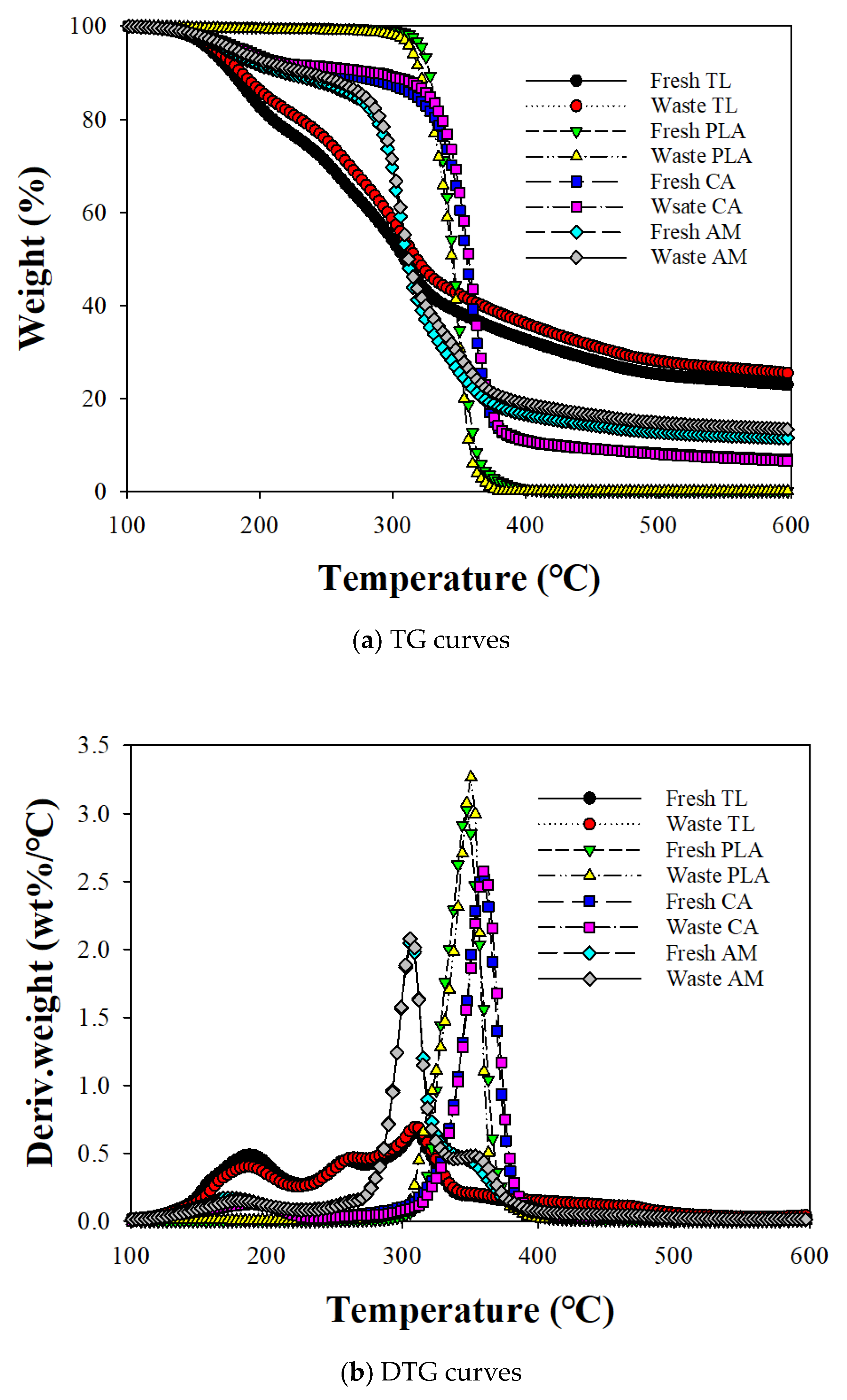
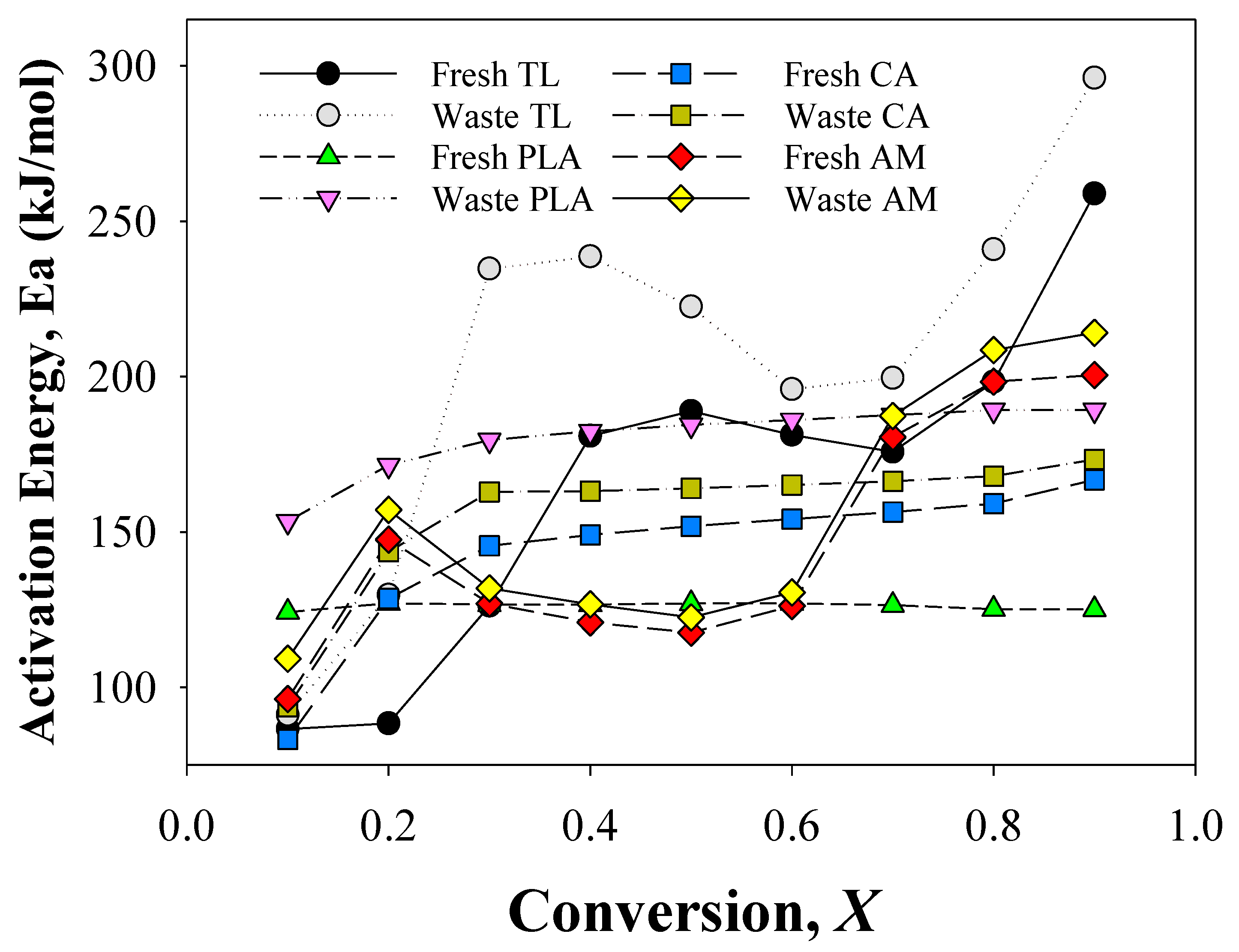
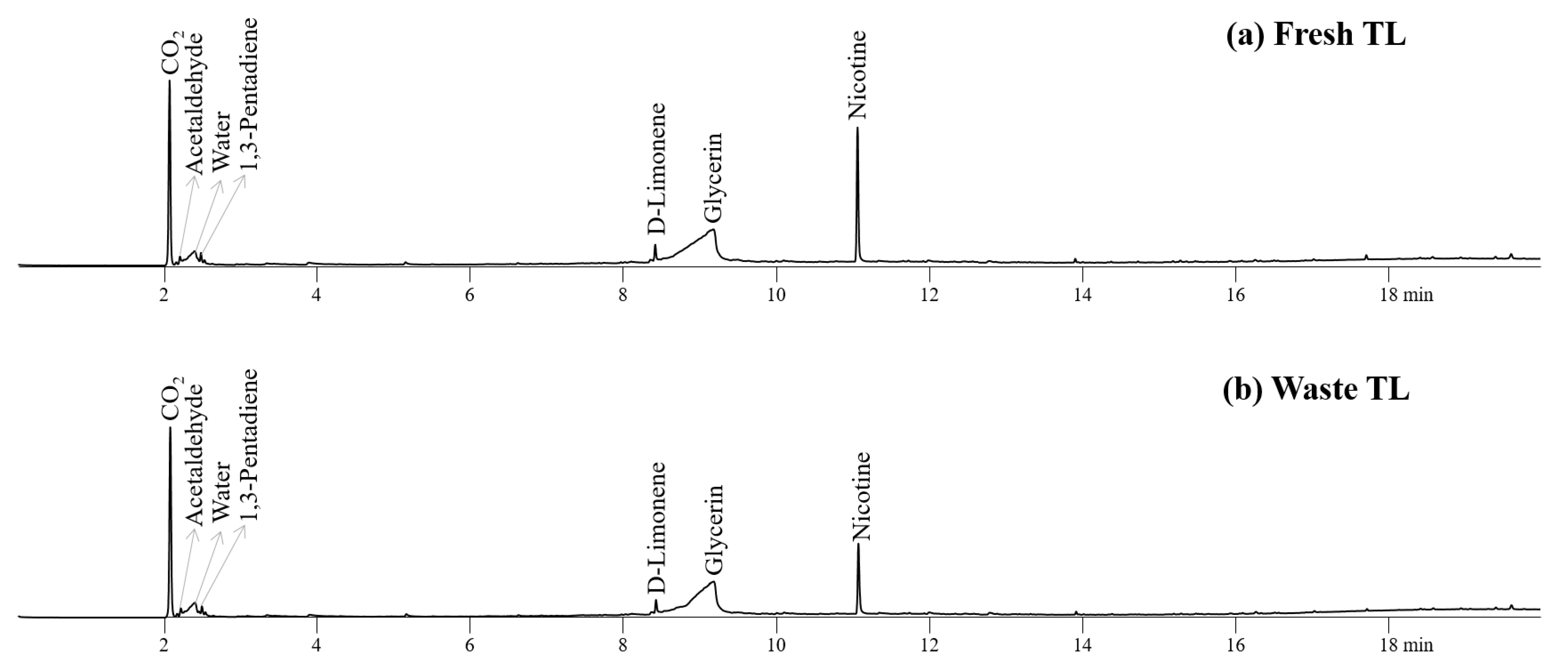
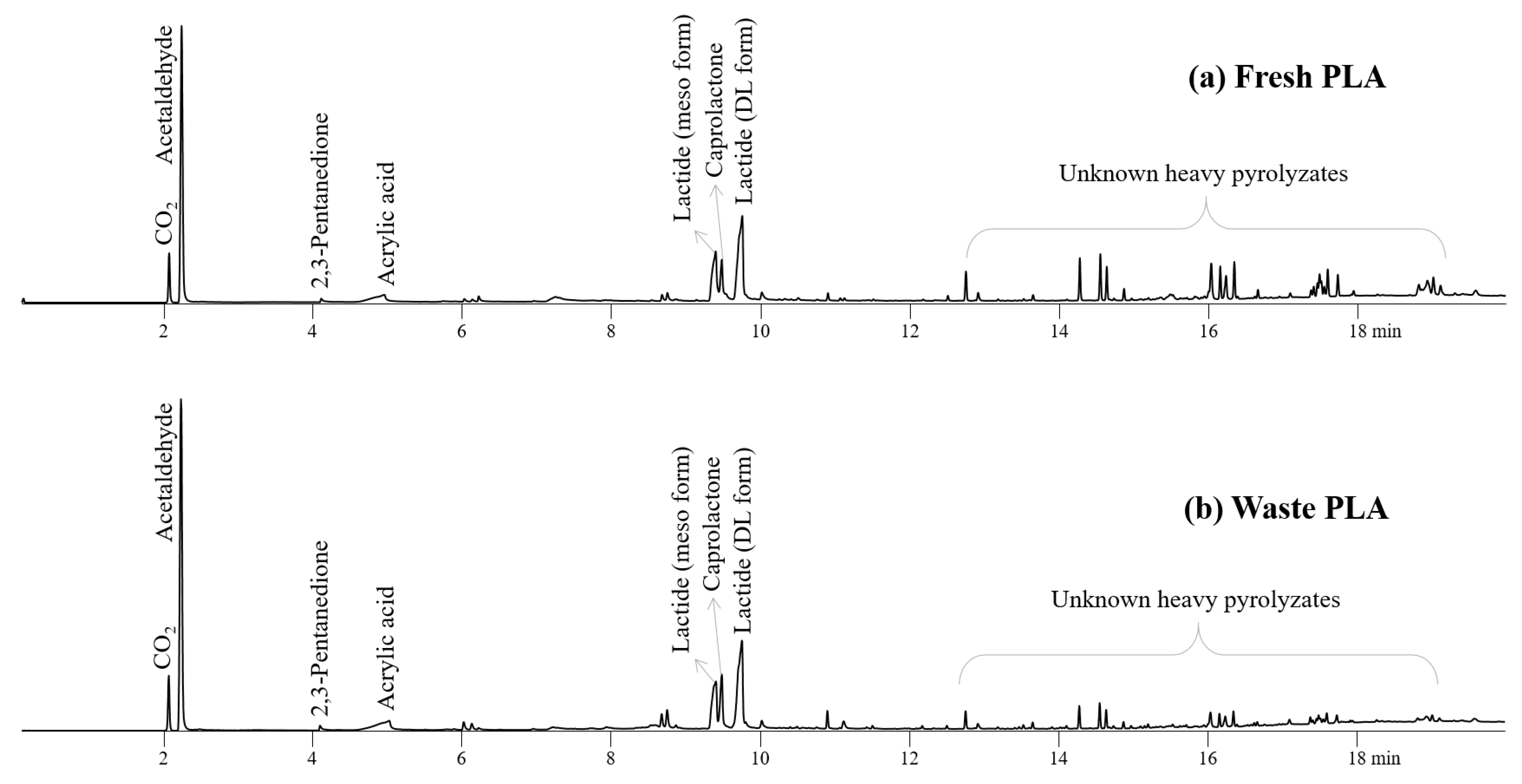

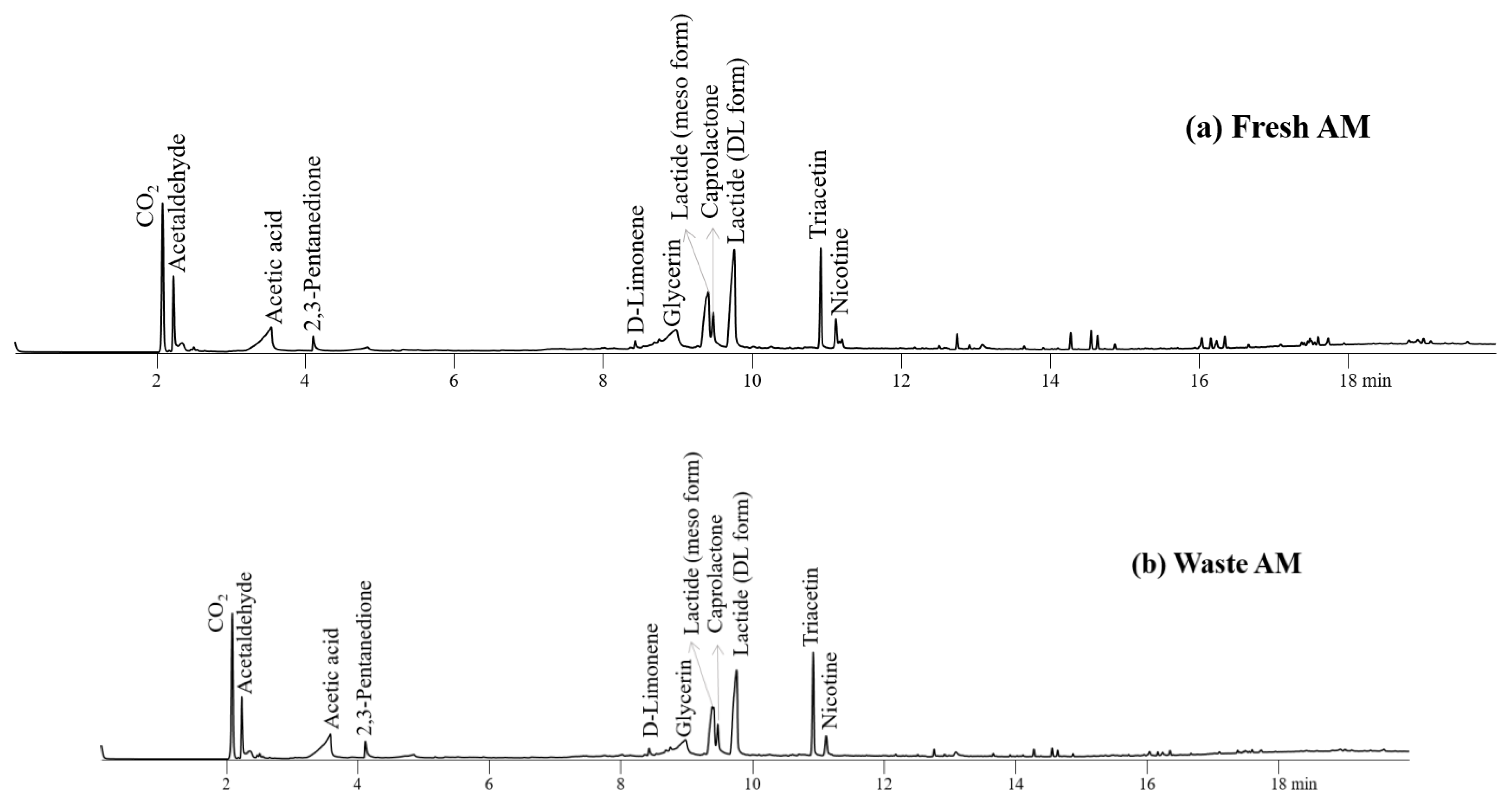
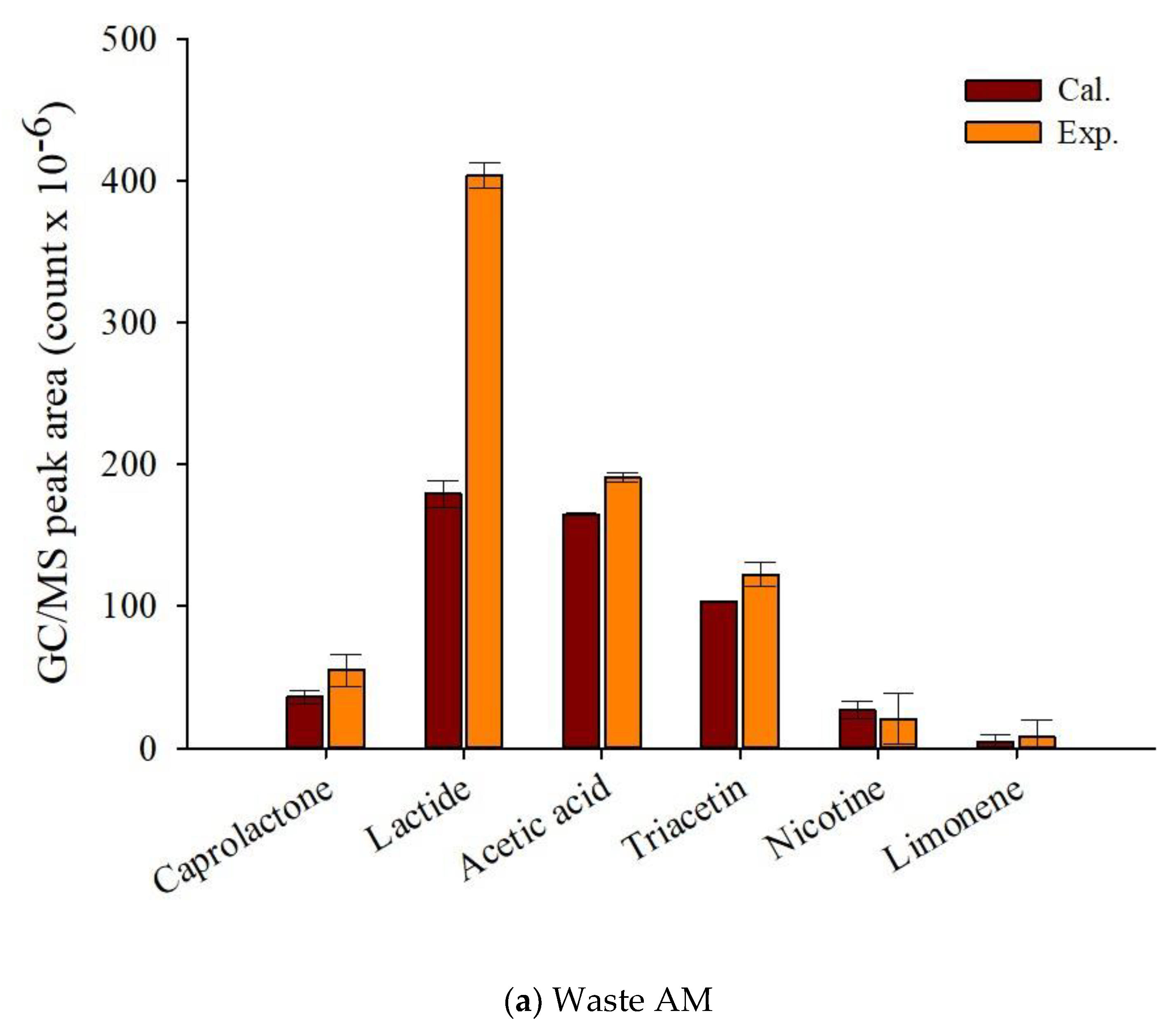

| TL | PLA | CA | ||
|---|---|---|---|---|
| Proximate | Volatiles | 82.6 | 99.1 | 92.8 |
| Fixed carbon | 3.5 | 0.9 | 5.2 | |
| Ash | 13.9 | N.D. | 2.0 | |
| Sum | 100.0 | 100.0 | 100.0 | |
| Ultimate | Carbon | 48.4 | 51.1 | 48.8 |
| Hydrogen | 8.5 | 7.1 | 6.4 | |
| Oxygen | 39.1 | 41.4 | 44.5 | |
| Nitrogen | 2.2 | N.D. | N.D. | |
| Sulfur | 1.8 | 0.4 | 0.3 | |
| Sum | 100.0 | 100.0 | 100.0 |
Publisher’s Note: MDPI stays neutral with regard to jurisdictional claims in published maps and institutional affiliations. |
© 2021 by the authors. Licensee MDPI, Basel, Switzerland. This article is an open access article distributed under the terms and conditions of the Creative Commons Attribution (CC BY) license (https://creativecommons.org/licenses/by/4.0/).
Share and Cite
Choi, Y.; Jeong, S.; Park, Y.-K.; Kim, H.; Lim, S.-J.; Woo, G.-J.; Pyo, S.; Siddiqui, M.Z.; Kim, Y.-M. Chemical Feedstock Recovery via the Pyrolysis of Electronically Heated Tobacco Wastes. Sustainability 2021, 13, 12856. https://doi.org/10.3390/su132212856
Choi Y, Jeong S, Park Y-K, Kim H, Lim S-J, Woo G-J, Pyo S, Siddiqui MZ, Kim Y-M. Chemical Feedstock Recovery via the Pyrolysis of Electronically Heated Tobacco Wastes. Sustainability. 2021; 13(22):12856. https://doi.org/10.3390/su132212856
Chicago/Turabian StyleChoi, Yejin, Sangjae Jeong, Young-Kwon Park, Huijeong Kim, Se-Jeong Lim, Gi-Jeong Woo, Sumin Pyo, Muhammad Zain Siddiqui, and Young-Min Kim. 2021. "Chemical Feedstock Recovery via the Pyrolysis of Electronically Heated Tobacco Wastes" Sustainability 13, no. 22: 12856. https://doi.org/10.3390/su132212856








